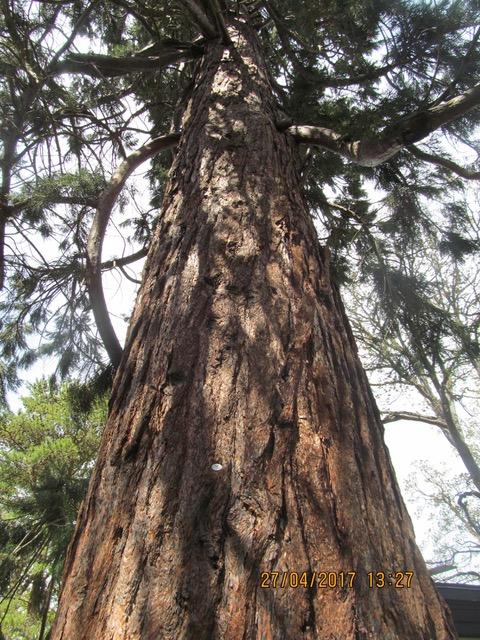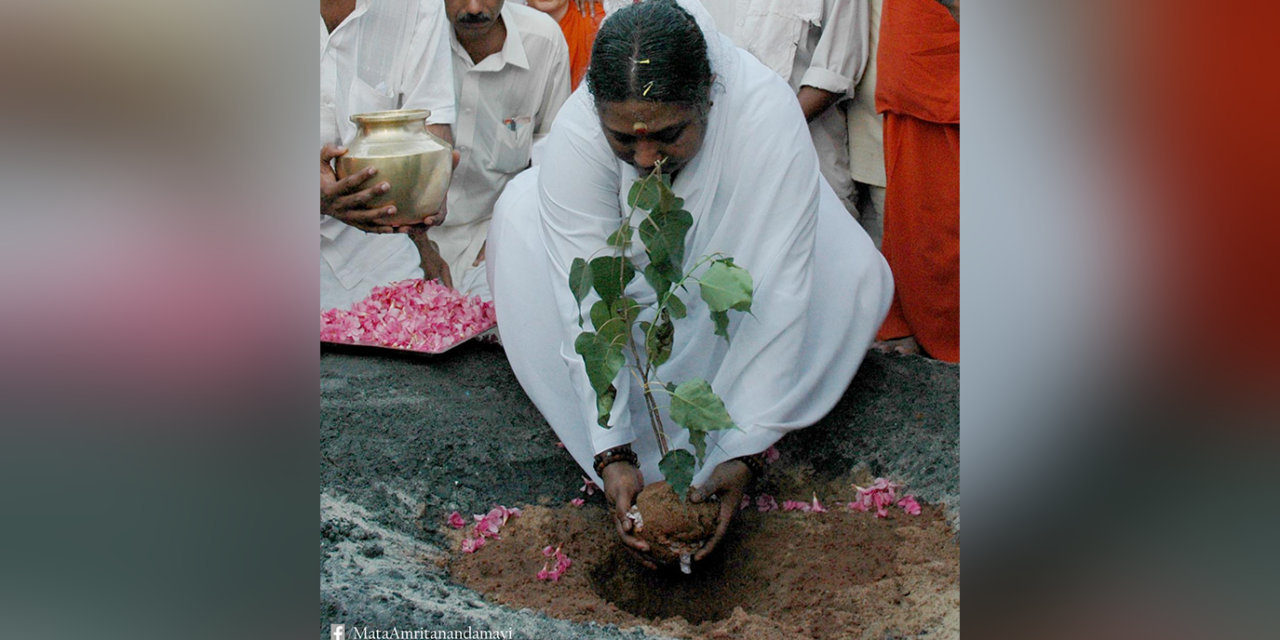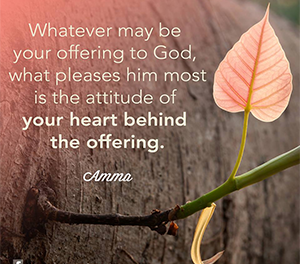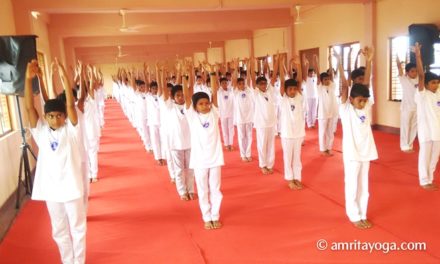“The creation and the Creator are not two but One,” Amma constantly reminds us. It is this principle that informs and motivates the various environmental programs and green initiatives of Embracing the World. India’s culture is one wherein everything one sees serves as a reminder of the all-pervasive nature of the Divine. At its heart, this perspective acknowledges that all names and forms are but various manifestations of the one all-pervasive consciousness that serves as the substratum of creation.
Nature is a beautiful expression of the creation, and in Nature, many people find a connection within, a space for reflection, and a refuge. Once we begin to feel this connection, we often feel inspired to serve all living beings. Amma says, “Only through love and compassion is the protection and preservation of Nature possible.” Amma’s green initiatives are a natural place for work and worship to come together.
When we see the interconnection of all beings, how will we dump toxic waste into rivers? How will we destroy our forests? How will we allow poisonous fumes from factories to pollute the atmosphere?
From Amma’s inspiration, green initiatives are happening all over the world. Tirtha, a devotee from Canada, writes about the importance of urban forests and the efforts that she and a few friends have made to protect the trees in Victoria, and tips for protecting forests in your own town.
Forests play the most important role in maintaining Nature’s harmony. It is only due to them that there is any semblance of harmony in the world today. Each country should try to protect its remaining forests and plant as many trees as possible. – Amma
One way to help Mother Nature is to start an urban forest protection group

Most of the trees in this Victoria view no longer exist…
Did you know a significant portion of most countries’ forests lies within their cities? Like their brothers and sisters in rural forests, city-dwelling trees do an enormous amount of good for us and the planet.
Here are just some of the benefits of the urban forest:
- Trees store carbon dioxide, so they can help reduce the effects of global warming.
- They cool the air and provide shade during the day. Shaded pavement gives off less heat at night.
- Because of the shade from street trees, sidewalks and pavement can last years longer.
- Trees produce oxygen (two average, healthy trees can provide enough oxygen for a family of four).
- Trees reduce wind. With climate change, winds are increasing.
- Studies have found that living or working near trees can strengthen our immune systems, reduce stress, and improve both mental and physical health.
- Trees provide food and refuge for birds and wildlife.
It is no wonder then that Amma suggests we plant trees and protect forests. Trees support life in so many ways! Among many other projects, Amma has inspired the InDeed Campaign for Nature. People from 40 countries have planted more than one million trees since 2001.
Unfortunately, not everyone appreciates trees. In my Canadian city, Victoria, a developer recently cut down 29 trees on a 1.76 acre downtown property to build a luxury townhouse and condo. These trees included two historic Giant Sequoias, planted just after Canada was born. Sequoias store far more carbon than any other species of tree. So at 150 years, these trees were still in their youth. Their species can live 2000 to 3000 years! Many of us felt it was a tragedy. We desperately need trees to mitigate climate change, clean and filter the air, reduce storm water, retain topsoil, and buffer sound, among other things. The project could have accommodated these trees. And the same thing is happening all over the world.
Last summer, three of us with a common concern for the urban forest started Community Trees Matter Network. Just six months later, we have more than 150 members and 300 followers on Facebook. Clearly, urban tree loss is important to a lot of people!
We had all noticed more and more trees in our region being lost to development. And more publicly owned street trees are dying because of now common summer droughts.
We initially planned to focus on increasing the public’s awareness of the value of trees. However, some of our active members are quite political, so we have also made presentations to local municipal councils and are developing relationships with some of the ‘greener’ councillors and city staff. We are directly asking for better tree protection and to make tree planting a bigger priority in our city.
The UN’s warning that we have only 12 years to make drastic changes to avoid catastrophic climate change really affected us. Since trees store carbon, and mature trees store exponentially more carbon than saplings, we stress the importance of preserving mature trees. It can take 200 to 300 saplings to produce the carbon storage of one large tree.
Our group held a public ‘Goodbye and thank you’ for those 29 trees. We gathered in front of the property to sing songs, share tree poems, and send love and gratitude to those beings who gave so much to our community.

One of the giant sequoias, still a kid at 150 years old, might have lived another 2,000 years; it would have absorbed an immense amount of carbon. And we keep hearing about even more such trees being cut down! For those of who love trees, this is very painful.
But we remind ourselves to enjoy the trees we still have with us and to savor our victories. We played a part in saving about 50 trees in one neighbourhood from being cut down for a new sewage line. Council also listened to us and the neighbourhood when we requested another 20 or more big trees not be cut down for a new swimming pool. They chose another site for the pool, one where no trees would need to be removed. Our city council appreciated our presentations and is moving ahead with making tree preservation a bigger priority, including giving the parks department a bigger budget.
We may doubt whether we have the power to restore the lost balance in nature. We may ask, ‘Aren’t we human beings too limited?’ No, we are not! We have infinite power within us, but we are fast asleep and unaware of our strength. This power will rise up when we awaken within. – Amma
How to start an urban forest advocacy group
We were very fortunate to start off with a couple of experienced writers and photographers among our early members. Both are helpful if you are sending out news releases or writing articles to raise awareness. If you don’t have writers or photographers, try to recruit some, but don’t wait around – you can still be active and effective without them. Good public speakers are also valuable. But even a normal, nervous speaker can make a difference by speaking with sincerity.
- Try using Meetup to find more people interested in joining you. Also connect with local environmental groups. Neighbourhood groups often try to protect trees in their area. By banding together, we can put more pressure on communities to value trees.
- Take the time to do good research, and stick with the facts. You’ll be able to use that information over again. But if it’s not accurate, trust will be lost.
- Study the tree policies on your city’s website, and also learn something about the policies of nearby municipalities. Find out what the best existing practices are in other places too.For instance, Victoria’s bylaw protects non-native trees from being cut down only when they are 80 cm (about 31.5 inches) in diameter or bigger. Vancouver, on the other hand, has a newer bylaw that protects non-native trees from a much smaller size – 20 cm (nearly 8 inches). Armed with knowledge like this, you can make stronger demands for better bylaws.
- Some very good advice from a Vancouver politician, Sarah Blyth: Don’t just tell politicians what they’re doing wrong. Suggest a solution. Make a case for it. She says, “Be tough, and present it so that no one can say no to it, because it’s the right thing to do.”
- Write letters to the editor regarding local tree issues. Sign your name and the name of your group.
- If you have a Facebook or social media information page, you can post and share informative articles about trees, and also notify people about local issues.
- Make a list of local media: newspapers, online news, local TV and radio stations, etc. Find out where to send news items. Letters to the editor may need to be sent to a different email address.
- Learn how to take good photos. Your news release stands a better chance of being published if it’s accompanied by a well-focused, clear, interesting photo with no visual clutter.
- Learn how to write a news release or media release. You can find information online about this. Your news release should have a contact person from your group, phone number and email address. It should explain who, what, where, when, why and how. Make the first lines as lively and interesting as possible, so people read on. Keep it short and informative.
- Your news release may not be used. Don’t be discouraged; there may not have been room for it. Many newspapers are thin these days. But papers generally do want interesting local news stories, and you’re giving them one. They also might edit it, or cut its length. But even if it’s not printed, the editors will become more aware of your group and activities, and know that people are interested in trees.
- Is there a regional or federal tree planting or ‘tree appreciation day’ in your country or area? Before that date, take a great photo of one or several volunteers planting trees. Send out a short news release about it. You can add some of the benefits trees give us, and encourage people to plant trees.
- Write an opinion editorial for a local paper about the importance of trees, or to draw attention to a local tree issue. Include lots of facts. Most people don’t know all the amazing things trees do for us and the planet.
- Find out if your group can meet with Parks staff to ask questions about policies you don’t like. Make sure you read the information your city has on its website about its tree policies. It helps if you can say, for instance, “Your policy is to post a notice at least 10 days before a publicly owned tree is cut down, and that doesn’t seem to be happening.”
- Find out if your group can make a presentation to your municipal council or regional government. If possible, get lots of supporters to show up. We asked people to bring or wear something tree related in order to stand out. Several of our members spoke at recent council meetings, and it seemed to have quite an effect on the councillors. (Parks staff even broke out in applause at one point, although applauding is not permitted.) Other members have met with councillors and/or parks staff.
- Think about building bridges. Even if you’re frustrated, make it clear you’re criticizing the policies, not the people. Ask what are the reasons for the policies. Maybe your group can suggest realistic alternatives. Hopefully you will have long relationships and it helps if they can be as positive as possible.
- If there’s an election coming up, try to make trees an election issue. Several of our members attended all-candidates’ meetings, to publicly ask questions about how they would respond to our concerns. We also came up with a list of urban tree related questions, and emailed them to every single candidate, mentioning we planned to post the results on our website. Many replied, some with obvious sincerity. We posted all the replies, referred to it on Facebook, and asked people to share it widely. It has also come in handy since the election, to refer back to who said what (some had good suggestions), and who might give us a receptive ear.
- If you can afford it, have some business cards printed up with your group’s name and email address. Members can hand them out when they attend events, if people are interested in joining.
- In an email to our group members, we wrote a sample letter to city council (this one urged council to implement and budget the funding for the Urban Forest Master Plan council endorsed five years ago, which has not yet been acted on). We sent it to everyone on our email list, asking them to copy and paste the letter, add to it or edit it if they chose, sign it, and send it on to the city. We gave them councillors’ email addresses (usually available online). It was quite well-used. One person rewrote it slightly and requested a response. She received one promptly. It was helpful to know the letters were being read.
- Now that we are more well-known, people tell us about trees that are threatened in their neighbourhoods. It helps to know city staff you can call or email with a question such as, “Someone is claiming that a tree is being poisoned; does this sound like a possibility?”
We have learned that we can’t fight every tree battle. Sometimes we simply offer suggestions or write an informative post on Facebook.
This year, our group plans to host a series of speakers on the subject of trees, to help increase awareness of their importance, and how many we’re losing.
Some of the other activities we’re considering include: talking to school classes about all the things trees do for us; talking to neighbourhood associations about the importance of trees; giving an annual award to the local municipality with the most positive tree policies; and hosting a children’s art and essay contest focusing on trees.
Good luck! Please let us know how your tree advocacy group grows and develops!
It is high time to give serious thought to protecting nature. The destruction of nature is synonymous with the destruction of humanity. Trees, animals, birds, plants, forests, mountains, lakes and rivers – everything that exists in nature – are in desperate need of our kindness, compassionate care and protection. If we protect them, they in turn will protect us. – Amma




